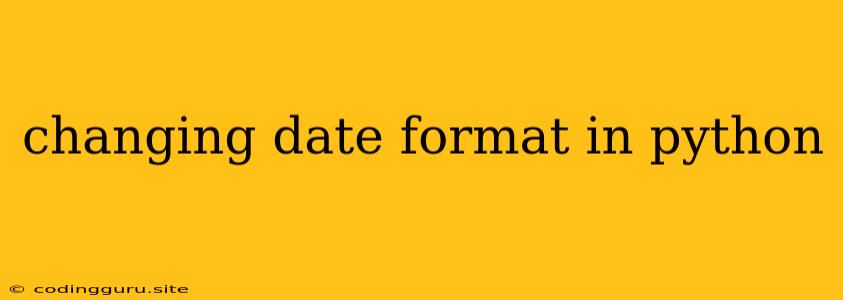Changing Date Format in Python: A Comprehensive Guide
Working with dates in Python is a common task, and often you'll need to manipulate them to fit a specific format. This guide will walk you through the process of changing date formats in Python, covering various scenarios and providing clear explanations.
Understanding the Basics
Python offers the datetime module, which provides powerful tools for working with dates and times. The datetime module offers several key classes:
datetime.datetime: Represents a date and time.datetime.date: Represents a date.datetime.time: Represents a time.
The strftime() Method
The strftime() method is your primary tool for formatting dates in Python. It takes a format code string and returns a formatted date string. Here's a breakdown of common format codes:
| Code | Description | Example |
|---|---|---|
%Y |
Year with century | 2023 |
%y |
Year without century | 23 |
%m |
Month as a zero-padded number | 01, 02, ... 12 |
%B |
Month as a full name | January, February, ... December |
%d |
Day of the month as a zero-padded number | 01, 02, ... 31 |
%H |
Hour (24-hour clock) | 00, 01, ... 23 |
%I |
Hour (12-hour clock) | 01, 02, ... 12 |
%M |
Minute as a zero-padded number | 00, 01, ... 59 |
%S |
Second as a zero-padded number | 00, 01, ... 59 |
%A |
Day of the week as a full name | Monday, Tuesday, ... Sunday |
%a |
Day of the week as an abbreviated name | Mon, Tue, ... Sun |
Examples of Changing Date Formats
Let's dive into some concrete examples:
1. From "YYYY-MM-DD" to "DD/MM/YYYY"
from datetime import datetime
date_string = "2023-08-15"
date_object = datetime.strptime(date_string, "%Y-%m-%d")
formatted_date = date_object.strftime("%d/%m/%Y")
print(formatted_date) # Output: 15/08/2023
In this example, we first convert the string "2023-08-15" to a datetime object using strptime(). Then, we use strftime() to format it as "DD/MM/YYYY".
2. From "YYYY-MM-DD HH:MM:SS" to "Month DD, YYYY"
from datetime import datetime
datetime_string = "2023-08-15 14:30:25"
datetime_object = datetime.strptime(datetime_string, "%Y-%m-%d %H:%M:%S")
formatted_datetime = datetime_object.strftime("%B %d, %Y")
print(formatted_datetime) # Output: August 15, 2023
Here, we convert a datetime string to a datetime object and then format it to display the month, day, and year.
3. Custom Formatting with Multiple Elements
from datetime import datetime
datetime_string = "2023-08-15 14:30:25"
datetime_object = datetime.strptime(datetime_string, "%Y-%m-%d %H:%M:%S")
formatted_datetime = datetime_object.strftime("%A, %B %d, %Y at %I:%M %p")
print(formatted_datetime) # Output: Tuesday, August 15, 2023 at 02:30 PM
This example showcases how you can combine various format codes to create more complex date representations.
4. Handling Time Zones
When working with time zones, you'll need to be extra careful. Python's datetime module doesn't inherently handle time zones. You'll likely need a library like pytz to manage time zone information.
from datetime import datetime
import pytz
# Assuming you have a datetime object
datetime_object = datetime.now()
# Set the timezone to UTC
utc = pytz.utc
datetime_object = utc.localize(datetime_object)
# Convert to another timezone (e.g., US/Pacific)
pacific = pytz.timezone('US/Pacific')
datetime_object = datetime_object.astimezone(pacific)
formatted_datetime = datetime_object.strftime("%Y-%m-%d %H:%M:%S %Z%z")
print(formatted_datetime) # Output: Example: 2023-08-15 17:30:25 PST-0700
This example demonstrates how to work with time zones using pytz.
5. Working with Time Deltas
If you need to add or subtract time from a date, use the timedelta object:
from datetime import datetime, timedelta
date_object = datetime.now()
new_date = date_object + timedelta(days=7)
formatted_date = new_date.strftime("%Y-%m-%d")
print(formatted_date) # Output: Example: 2023-08-22
This example adds 7 days to the current date.
Common Pitfalls
- Incorrect Format Codes: Ensure you use the correct
strftime()format codes. A simple typo can lead to unexpected results. - Time Zones: Remember to consider time zones when working with dates and times, especially if your data comes from different locations.
Tips for Effective Date Formatting in Python
- Start with a
datetimeobject: Most operations are easier when working withdatetimeobjects rather than strings. - Use
strptime()carefully: Make sure your format string matches the structure of your input date string exactly. - Test thoroughly: Always test your formatting logic with different input dates to catch any potential errors.
Conclusion
Changing date formats in Python is essential for many data manipulation tasks. By understanding the datetime module, the strftime() method, and the various format codes, you can easily transform dates into the desired format for your application. Remember to handle time zones carefully and always test your code thoroughly to ensure accuracy.
